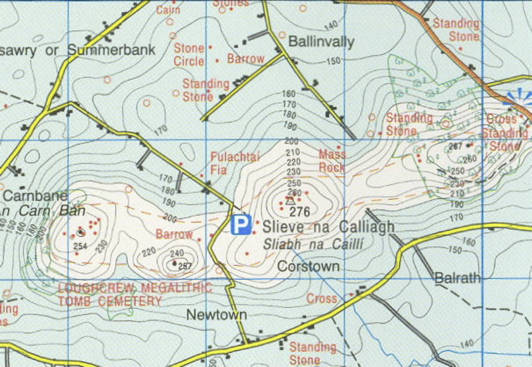Barrow Way
The River Barrow vies with one of its sister rivers, the Suir, as the second longest river in Ireland. It rises in the Slieve Bloom Mountains in the southern midlands, and flows to join its two €˜sisters', the Nore and the Suir, before flowing into the Celtic Sea at Waterford Harbour. The Barrow was made navigable in the eighteenth century by the insertion of short sections of canal along its course, and the 114km long Barrow Way follows surviving towpaths and riverside roads from the canal hamlet of Lowtown in County Kildare to the beautiful monastic site and village of St Mullins in south County Carlow. It is a peaceful route through a quiet sylvan landscape, with the constantly expanding river, growing more majestic every mile, for company. Terrain consists mainly of grassy towpaths, tracks and quiet roads. Overnight accommodation options are good: the route is frequently punctuated with villages and towns, many of which were founded at fording places by the Normans soon after the invasion. Among the interesting places the route passes through and walkers might wish to linger a while are the towns of Rathangan with its great hosting place, and Athy and Carlow. Borris in South County Carlow is a fine place that grew up around Borris House, the homeplace of the McMurrough Kavanagh clan, and Graiguenamanagh, a quaint old monastic town where a book festival is held every year, is Ireland's Hay-on-Wye.
Maps and other information
External Links
Trail Management
Waterways Ireland,
Floor 2 Block C,
Ashtowngate,
Dublin 15
Tel 01-8680148
Email: info@waterwaysireland.org
Facilities
Car parking
At Start - on street in Robertstown
At End - on riverbank or near Abbey in St. Mullins
9 kms or 9% of the Way follows local roads.
***Dogs under effective control allowed, please clean up after your dog***

Map Guides
Guide to the Barrow Navigation of Ireland - Inland Waterways Association of Ireland. Informarion also available from Waterways Ireland.

OSI Maps

Public Transportation
At Start: Bus to Robertstown.
Check with Bus Eireann.
At End: None at present.
Mary from Cork
We got to just camping on the side of the grass path about 1 or 2 km outside of Vicarstown. Day 1 covering 36km, we set off on day 2 finishing up in Carlow. This part of the walk is a little boring and might lend itself to cycling more to be honest, easy though and lots of places to get cuppas along the way. We stayed in a hotel in Carlow at end of day 2, I would say if you were camping find a spot 2-4 km before Carlow town or about 2k after, you could find spots by the river in the town to camp but it wasn't very appealing. At the start of day 3 we walked to Milford and picked up a canoe to do the rest of the route. I don't really recommend this unless you can paddle down weirs, we ended up going through the many locks and it was pretty frustrating (the lock at Bagnelstown is pretty manky), but it was also really really beautiful, we saw lots of birds and plant life and fish up close. Slyguff is a great place to camp, so beautiful this is where we finished day 3. Clashganny lock is a spot with bathrooms (if i am remembering right). On day 4 we ditched the canoe at Graiguenamanagh got coffee at a cafe/flower shop, where we were treated to some conspiracy theories from the owner, fun! (be warned!).
We finished day 4 walking to St. Mullins. Overall, it was very pretty, pretty easy, but a little boring. Second half is definitely nicer so you could probably start the walk at Carlow town and go from there if you were stuck for time.
Frieda from Cork
Aaron from Kildare
Brian from Kilkenny
The only other downside is it would be far better for cyclists if the track was tarmaced the entire way as punctures are a quite possible
Have fun
Michael from Kilkenny
You can actually keep going all the way to Dublin once you reach Athy.
Patrick from Carlow
As I travel by myself and enjoy the solitude, the one thing that disturbs my peace is irresponsible dog owners who assume that travellers don't feel threatened by dog walkers with two or more dogs - not on leashes. The assumption of these dog owners is that everyone out on a walk likes dogs rushing and barking at them. For me at least when I see someone approach on the Barrow Way is if they have let their dog off the leash or not and how many dogs they have decided to bring on the walk.
Another issue I have is the signage, before Milford Waterways Ireland blocked the walkway and provided inadequate instructions as to where the traveller could re-enter the Barrow Way. Indeed, I followed their instructions and had to travel on a very busy rural road and when I tried to get on the Barrow Way again, I was attacked by a large dog and had to work out myself how to continue my walk on the Barrow Way.
Terrible pity that travellers should be made so apprehensive to use such a valuable facility.
Let's get this right and make dog owners aware of their responsibilities and come on Waterways Ireland, really? Get your act together and get help if you can't come up with adequate signage.
Today, I travelled from Carlow to Bagnelstown. To get back, because of my experiences, dog and bad signage, I decided to travel back by the back road to Carlow. Couldn't hack the off-road experience!
Martin from Tyrone
Pat from Wicklow
David from Dublin
Would be vastly improved for riders if there was a sealed/graveled surface throughout (even a narrow strip). Walk-able throughout.
Wukasch from Dublin
It's disheartening to discover that Ireland has a scarcity of proper off-road walking trails. The Burrow Way, unfortunately, concludes in the small village of St. Mullin's, falling short of extending to the point where the River Barrow discharges into the Irish Sea. The decision not to continue the trail to this significant natural endpoint is difficult to understand, leaving the Burrow Way to end abruptly in the middle of nowhere in the quaint village of St. Mullin's. This choice seems perplexing and leans towards the ridiculous.